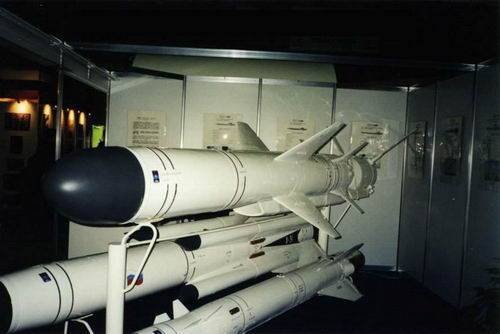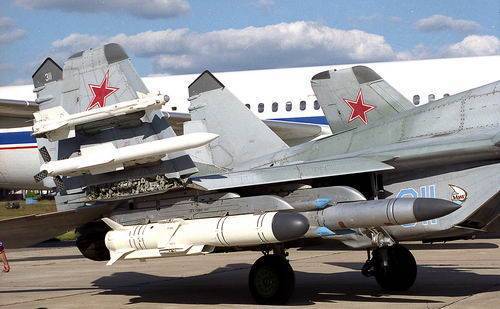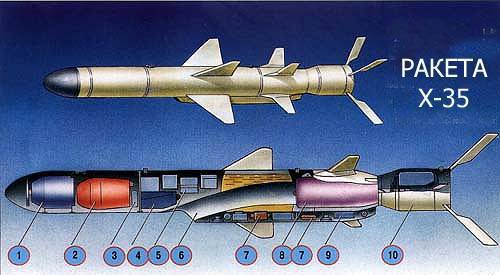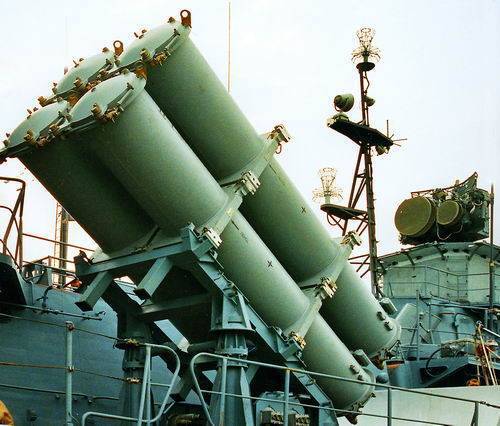Poseidon Weapon
On the night of 24 March 1986, a target appeared on the radar screens of the American cruiser “Yorktown”, which was in 70 miles from the Libyan coast. Initially, she was classified as a fishing vessel, but the cruiser commander ordered the observation to continue. When the distance between the ships decreased to 11 miles, the radar unexpectedly started working on the latter, which was turned off after the second turn of the antenna was completed. But that was enough to have a target classified at Yorktown using a radio intelligence station: this is the large missile boat of the Libyan Navy Ein Zaguit (Ean Zaguit, a former Soviet R & D project of 1234), which was located in 20 miles to the west of Benghazi. The boat was maneuvering at low speed, the running lights were off, all radio electronic equipment was turned off.
The American cruiser immediately fired two Harpoon missiles ("Harpoon") - and both of them hit the target. The first one pierced the board just above the waterline and exploded in the engine room. The boat lost speed, the onboard network was de-energized. There was a hole in the board with an area of about 20 square meters, through which water began to flow. After hitting the second rocket on the boat there was a strong fire, as the unburned and half the fuel of the rocket exploded around the ship. The fire intensified and in five minutes covered the whole boat. With trim aft, he began to sink quickly and sank in 15 minutes. The whole crew of the boat died. This was the first case of the combat use of Garpun guided missiles developed by McDonnell Douglas and adopted by the US Navy in 1980.

Russian project
From the beginning of 1960, the design of anti-ship missiles (ASM) in the USSR was practically monopolized by V.N. Chelomey, who headed the OKB-52. In 1959, the P-5 shipboard projectile was put into service. Outwardly, he really looked like a jet fighter. But, although the name “projectile” perfectly suited the products of Chelomey, in the USSR in 1959, this term was officially replaced by the phrase “cruise missile”.
Subsequent ship missiles Chelomey P-6, P-35, "Basalt", "Vulcan" and "Granite", in simple terms, were "grown up" P-5 - larger size and mass. If the starting weight of the P-5 was 5,2 tons, then at Granite it exceeded 7 tons. But the Americans were not fond of heavy rockets - by 1960, they had stopped work on the Regulus I and Regulus II ship projectiles.
Almost simultaneously with the start of work on the “Harpoon” in the Moscow city of Kaliningrad, the design bureau “Star” began designing a similar rocket, which received an X-35 index. Did our designers know about the development of McDonnell Douglas? And if they knew, to what extent? One can only guess about it. By the end of 1977, the design bureau Zvezda developed technical proposals for the creation of the Uran missile system with the X-35 anti-ship missile, intended for use as part of the ship, helicopter and aircraft weapon systems.
Product 78
Tests of the Uranus complex began in 1983 at the Sand Gully test site near Theodosia. Preliminary tests consisted of three stages. In the course of the first stage, mock-ups of rockets with the factory index X-35 (marine index 3М-24) were carried out. In addition, the missiles had another name - the product 78. The models were equipped only with autopilot, cruising and starting engines. During the first stage of testing (from 1983 to 1984 year) 6 models were launched from the coastal launcher located in the village of Chernomorsk (combat field of the test site), and one rocket launcher was launched from the sea carrier - the rocket boat P-44 of the 206MR project .
The second stage of testing was delayed by as many 5 years - from 1985 to 1990 a year - restructuring began. This time, the X-35 missile models were fully equipped, as well as with telemetry, only active radar homing devices were missing. A total of 5 years have produced a total of 26 launches, 18 from a coastal launcher and 8 from a boat. However, only half of the starts were recognized as successful.
Although the documentation noted that at the third stage, the mockups were also launched, in fact they were X-35 missiles in full configuration, including with an active radar homing head - they were launched at the 1784 project's SM target. Even in the official environment there was no agreement on this issue - in some documents the launches were called the third stage of preliminary tests, and in others - flight tests.
The third stage lasted more than 5 years, from 1992 to 1997 a year. During this time, four launches were carried out - one from the coastal launcher and three from the boat, the firing distance was 40 km. However, success was again just 50% - two hits were recorded at the target (both at launch from the boat).

Independent sabotage
The tests of missiles in 1992 – 1997 years at the Sand Girder range were carried out in extremely difficult conditions. And not because of financial problems. Several times, “independent protesters” tried to seize the landfill, and when they did not succeed, they engaged in systematic sabotage — they cut off electricity, banned the delivery of missiles to the landfill, or closed the water area for firing. However, at the end of June 1999, state (joint) tests of the entire Uranus complex began at the Sandy Beam range. The first launch was made on September 10 1999 of the target CM-148 (project 1784) at a distance of 40 km, and it was unsuccessful because of the failure of the steering rocket in the stabilization section. The second (February 14 2000 of the year under the same conditions) was counted successful. The third launch was also successful - on the CM-148 target at a distance of 120 km (22 March 2000).
But the last launch, 30 March 2000, ended in failure. The launcher of the left side of the boat fired, further it was supposed to turn the rocket 90 degrees, but the starting engine was not separated. The next day, March 31, a meeting of the State Commission was held, at which it was decided to take a break to analyze the causes and eliminate the shortcomings that occurred in the first four launches of state tests. However, after the Ukrainian Armed Forces shot down the Russian Tu-154 plane flying from Israel over the Black Sea, President Kuchma banned any missile firing in the area of Feodosia (as if an X-35 could shoot down an airliner!).
With great difficulty, another launch was made at the Sandy Beam range. 6 March 2001 of the year from the coastal position in the village of Chernomorsk from the Bal-E combat vehicle (3K-60) at the MKSh target was launched the X-35 rocket (at a minimum distance of 7 km with a shift to 90 degrees). But the launch was unsuccessful - the failure of the onboard control system ... We decided to restart the launch of the 206MR project boat. However, due to the sabotage of the Ukrainian authorities, it was not possible to carry it out. And only in the beginning of June 2003, the first launch of the X-35 rocket of the second stage of state tests took place, for the first time off the coast of Anapa, and not Theodosia. Shot from a boat at a distance of 7 km, the target was hit by a direct hit.
A total of nine X-35 missiles were launched in June, of which five were fully successful. All launches were carried out from the launch of the 206MP project at the target of the 1784М SM project. But the testers of the complex, and even Uranus itself, were very lucky, because at the end of the launches in the right place and at the right time there was a big boss - the Minister of Defense of Russia and the Commander-in-Chief of the Navy just arrived in Sevastopol. Naturally, they were very pleased to adopt the first Russian (and not Soviet) missile system, which was submitted for delivery in the last 12 years. Therefore, the final act of state tests of "Uranus" was sent to Moscow on July 28 2003. Soon the ship complex "Uranus" officially adopted.
The first ship equipped with the Uranus complex was the rocket boat P-44 of the 206MR project, from which they had been shooting all twenty years. But by the summer of 2000, both launchers of the Uranus complex were transferred to the destroyer Smetlivy, which became the second ship equipped with Uranus. However, in 2002, they were removed from the destroyer and returned to the rocket boat.

1. Radar homing head. 2. Penetrating warhead. 3. Self-destruction system. 4. Inertial guidance system. 5. Radio altimeter. 6. Air intake. 7. Fuel system. 8. Turbojet. 9. Steering drive. 10. Solid propellant accelerator.
"Uranus" in turban
Abroad ship complex was a great success. India decided to equip Godavari-type frigates of the 16 project with a full displacement of 3850 and the first three F-20, F-21 and F-22 frigates were armed with four single launchers П-20М (export version) "Termite"), and the next four frigates, starting with the F-31, are armed with four Uran-E launchers. In December 1999, the Indian Navy frigate of the 16 Delhi Project fired missile training with four 3M-24E missiles in the Indian Ocean. The shooting was carried out according to own target designation data in the manual input mode for the 47 km range (two missiles), the 80 km range (one rocket), and the 100 km range (one rocket) in a position from two sea targets such as a sea trawler. All four missiles hit the target.
In addition, the Indians decided to install "Uran-E" on corvettes of the type "Kukri" ("Khukri") with a displacement of 1350 tons. Moreover, the first four corvettes were built according to the 25 project (Р-44, Р-46, Р-47 and Р-49 ) and armed with two twin launchers missiles P-20M. And the next four corvettes (P-61 - P-64) were built according to the 25A project and were equipped with four Uran-E launchers.

Land brother
On the basis of the Uran ship complex, the Bal-E coastal missile system (3K-60 was created, the 3М-60 index is mentioned in the literature). The complex’s missiles are completely identical to the X-35 ship-based missiles, but the ground part is different. In addition to the missile, Bal-E includes two self-propelled command and control points, four self-propelled launchers (each equipped with an 8 block of transport and launch containers with X-35 missiles), four transport-handling machines and ground equipment for maintaining all machines and preparation of the coastal missile system for combat use.
Uranus or Harpoon
So is the Uranus missile inferior to the American Harpoon? In general, no, its private advantages and disadvantages compared to the American counterpart can be easily compensated for by competent tactical use. The trouble of "Uranus", as well as many types of naval weapons over the past 200 years - the incompetence of the Russian admirals, sometimes reaching the point of absurdity - which is at least worth the requirement to unify the Uranus launcher with the Onyx launcher (pseudonym Yakhont). No less important is the desire to save, including in the price of cruise missiles going for export, the cost of their refinement. And in the West, both the state and private firms “get out of their pants”, but bring turnkey cruise missiles “on a turnkey basis” and only then sell them to their customers. In this case, the cost of development is not covered from the first, but from the subsequent batches of missiles sold.
Comparative tactical and technical data of the RK "Uranus" and "Harpoon"
"Uranus". The length of 4,4 is m, the maximum diameter of the hull is 420 mm, the launch weight of the ship-based missile is 520 kg, the maximum firing range is 130 km, the weight of the warhead is 145 kg.
"Harpoon". The length of 3,8 is m, the maximum diameter of the hull is 340 mm, the launch weight of the ship-based missile is 520 kg, the maximum firing range is 120 km, the weight of the warhead is 227 kg.
Information